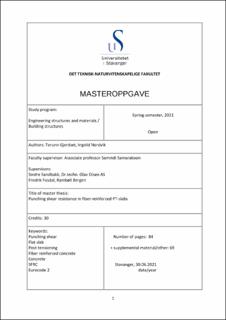| dc.description.abstract | Post-tensioned flat slabs with fiber-reinforced concrete can reduce cracking and deflections, provide longer spans, thinner slabs and provide a reduction in the weight of the structure due to reduced floor dead load. The solution also provides benefits such as reduced storey height, a large reduction in conventional reinforcement, as well as an overall more flexible design (The concrete society , 2005). However, the local shear per unit of length around columns in flat slabs can become very high, and this can result in local punching shear failure (Sørensen, 2013). Hence, this thesis aims to investigate the punching shear resistance in post-tensioned flat slabs with fiber reinforcement in accordance with proposed provisions in prEN 1992-1-1.
Initially the thesis presents a general study of different theory, design and calculations regarding flat slabs, fiber-reinforced concrete, and prestressed concrete. This part also includes a study of the current Eurocode 2, the proposed version of Eurocode 2, ACI 318-19, and FIB’s Model Code. Thereafter a parametric study of a flat slab was performed. In this study, the punching shear resistance around different critical control sections was controlled, and then compared with results from ADAPT and FEM-Design. Furthermore, the effect from different parameters in prEN 1992-1-1 and EN 1992-1-1 were compared.
The study showed that the fiber-reinforcement had the greatest contribution to the punching shear resistance according to the proposed provisions in Eurocode 2. The shear reinforcement had the second greatest contribution, although this contribution will vary. The purpose of the shear reinforcement is to account for the residual shear capacity and depending on the contribution from the fiber reinforcement, post-tensioning and shear force, this value will therefore be different depending on the given case. If the contribution is e.g. sufficiently high from the fiber, the required amount of shear reinforcement will be lower/not required, because there will be a higher capacity in the slab to withstand the shear force.
Furthermore, the study showed that the prestressing affected the punching shear resistance in a relatively small manner. The study also showed that the punching shear resistance was lower for EN-1992-1-1 compared to prEN 1992-1-1. However, the proposed version will give a lower capacity because the design shear force is increased due to the decreased critical control section.
The design methods presented in this study is intended to be read in conjunction with Eurocode 2 and the Norwegian National Annex. It should be noted that during the preparation of this thesis the final version of Eurocode 2 was not published, and the reader should confirm numerical values given in this method with the final version of Eurocode 2 and the Norwegian National Annex. | |
